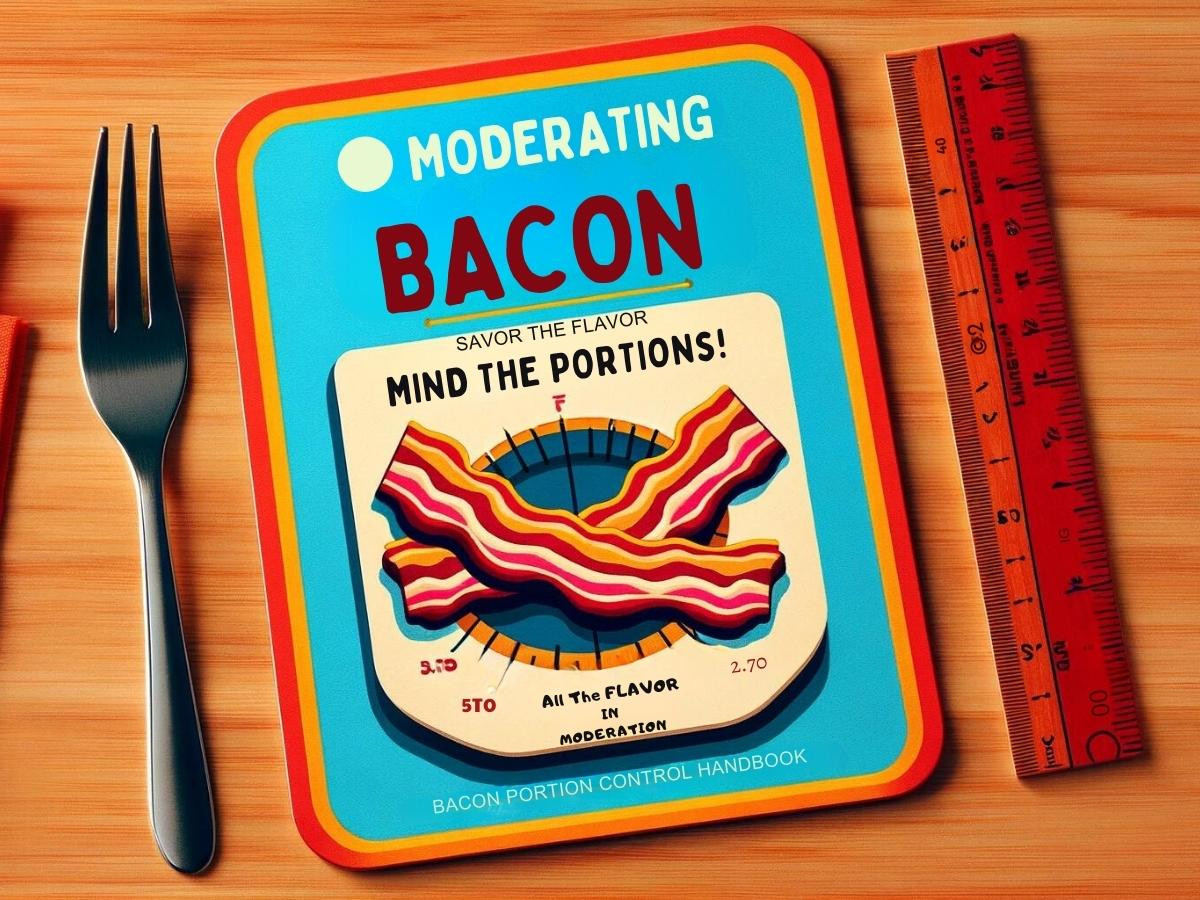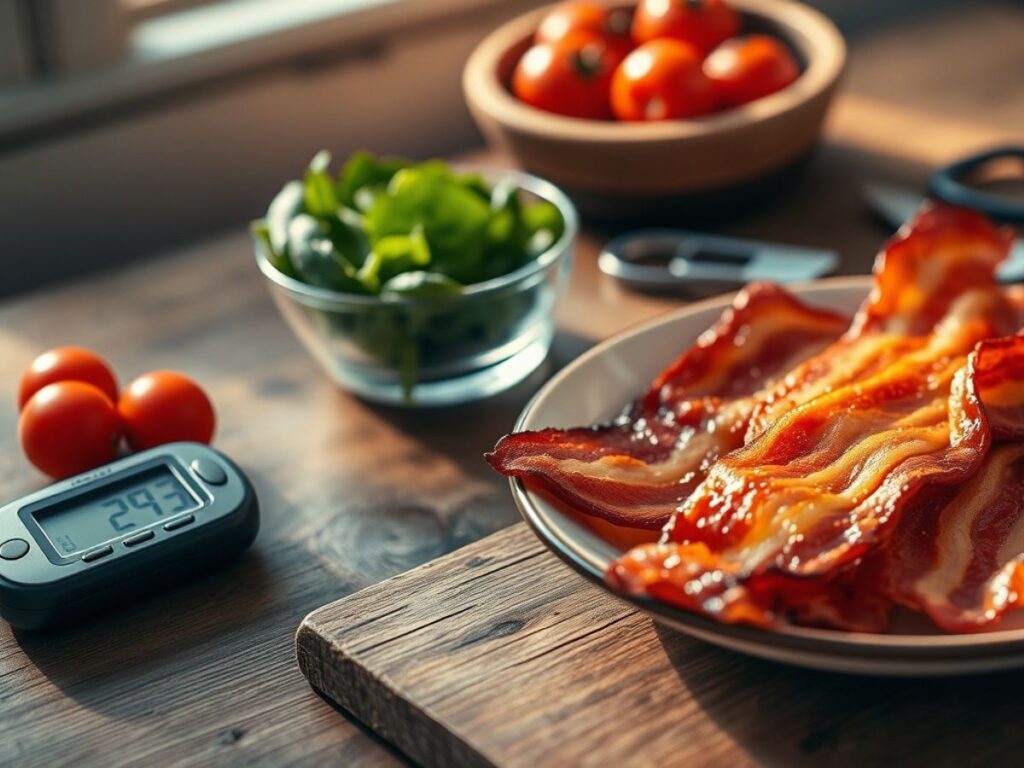Blood Sugar & Bacon: Can A Diabetic Eat Processed Meats?
People with Diabetes already have a tough time figuring out what they can or can not eat. Most foods they are allowed to eat must be eaten in moderation or at least appropriately portioned to prevent blood sugar levels from rising, with hidden sugars from saturated fats. The big question that often sizzles in the background is, “Can diabetics eat bacon?” And let me tell you, it’s a question that deserves more than a simple yes or no.

Healthy Fats Aren’t Healthy For Everyone
Growing up in a Sicilian household, where food is practically another language, I learned early on that every meal tells a story.
Now, as someone who’s seen firsthand how diabetes affects loved ones, I’ve become the family’s unofficial detective, investigating which foods can share the stage with diabetes without turning the drama into a tragedy.
Bacon, with its crispy edges and rich aroma, is often considered “questionable” for those of us monitoring blood glucose levels.
I’m going to hand deliver you the fact that bacon affects blood sugar levels and how, when enjoyed responsibly, according to the American diabetes association, it can still have a place on your plate.
Table of Contents
Can Diabetics Eat Bacon?

Yes, with a sprinkle of strategy and a dash of moderation, bacon can still sizzle on the plates of those with diabetes. Here’s how to enjoy it without derailing your health goals:
Let’s go ahead and get right to it. With some personal stories and a pinch of science, let’s see how a diabetic can enjoy those bacon bites while trying to regulate blood sugar levels.
1. Moderation Is Key

Why it matters: For individuals with diabetes, managing the intake of foods high in saturated fats and sodium, like traditional bacon, is crucial to avoid exacerbating insulin resistance and increasing cardiovascular risk.
Practical approach: Limit bacon to a few slices per week, treating it as a flavorful accent rather than the centerpiece of meals. This approach helps you enjoy the taste without consuming unhealthy fats.
2. Go for Quality

Lower-sodium options: Excess sodium can contribute to hypertension, a common condition in people with diabetes. Choosing lower-sodium, high-quality bacon helps manage blood pressure.
Nitrate-free bacon: Nitrates are preservatives that, when consumed in large amounts, may have health risks. Nitrate-free bacon is a healthier choice, reducing exposure to these compounds.
How to choose: Look for labels like “low sodium,” “reduced sodium,” or “nitrate-free” when shopping. Also, consider organic or pasture-raised options, which often contain fewer additives. Avoid adding sugary foods like maple syrup and bacon.
3. Balance Your Plate

Fiber’s role: High-fiber foods like vegetables and whole grains slow down glucose absorption and improve blood sugar control. They can also help mitigate the potential negative effects of saturated fats in bacon.
Example meals: Combine bacon with fiber-rich sides, like a salad with leafy greens, cherry tomatoes, cucumbers, and a sprinkle of seeds, or a side of quinoa or barley for a wholesome grain option.
4. Cooking Method Matters

Healthier cooking techniques: Baking or grilling bacon reduces the need for additional oils and can decrease the overall fat content by allowing some fat to drip away during cooking.
Why it’s better: These methods lower the fat content and reduce the formation of harmful compounds that can occur during frying.
Recipe Ideas for a Balanced Meal

Spinach and Bacon Salad: Enhance this dish with colorful vegetables like red bell peppers, carrots, and a homemade vinaigrette using olive oil and vinegar to control added sugars and unhealthy fats.
Bacon-Wrapped Asparagus: Perfect as a side dish, asparagus offers a hefty dose of fiber, vitamins, and antioxidants. For a healthier twist, try turkey bacon, which is leaner than pork bacon.
Bacon and Avocado Toast: Choose a high-fiber, whole-grain bread as the base. The avocado provides healthy fats, which can help with feeling full longer and stabilize blood sugar levels.
Monitoring Is Crucial
Why monitoring helps

Keeping track of how your blood sugar responds to eating bacon helps you understand your body’s tolerance and can guide future dietary choices.
Tips for monitoring

Use a blood glucose meter to check your levels before and after meals, including processed meat. Look for patterns and adjust your diet accordingly.
Incorporating bacon into a diabetes-friendly diet focuses on mindful choices, portion control, and balancing nutrients so that one can enjoy this favorite food without compromising health objectives.
By adopting these strategies, individuals with diabetes can safely savor bacon while maintaining control over their blood sugar levels and overall health.
Diabetes and Blood Sugar Management

Diabetes is about the body’s relationship with sugar—more specifically, glucose, the primary type of sugar in the blood. For those new to the diabetes scene, your body’s glucose management system is on a permanent vacation.
In type 1 diabetes, your pancreas throws in the towel when producing insulin. Type 2? Your body still produces insulin, but the cells have put up a “Do Not Disturb” sign, ignoring insulin’s attempts to manage blood sugar levels.
Now, why does all this talk about blood sugar matter, especially when eyeing that plate of bacon? Because managing blood sugar is the daily bread and butter of living with diabetes.
Let it swing too high or dip too low, and you’re in for a world of discomfort, not to mention long-term health complications. It’s all about keeping those levels as steady as Eddie, avoiding the highs and lows of the blood sugar rollercoaster.
Here’s where things get interesting. You might think, “Surely, bacon must be a blood sugar villain, right?” But the plot thickens. Unlike sugary treats and carb-heavy snacks that can send blood sugar into the stratosphere, bacon’s impact is more nuanced.
It’s packed with fats and protein, which don’t directly skyrocket your blood sugar levels like carbs.
Understanding the mechanics of diabetes and blood sugar management is the first step in making informed choices about what lands on your plate.
Bacon and Blood Sugar: The Facts

Bacon is high in fats, particularly saturated fats, and let’s not forget its buddies, sodium, and preservatives.
When you eat bacon, the fats don’t directly spike your blood sugar like carbohydrates do. This might sound like a free pass to lose weight and eat bacon freely, but it’s more of a “proceed with caution” sign.
The fat in bacon slows digestion, which can help avoid immediate spikes in blood sugar.
The saturated fat in bacon is a double-edged sword. Consuming it in excess is linked to heart disease, something people with diabetes are already at increased risk for.
So, while bacon might not directly affect blood sugar levels, it can contribute to cardiovascular complications that nobody wants on their plate.
Then there’s the sodium and preservatives. Bacon is often high in sodium, which can lead to hypertension, another risk factor for heart disease. The preservatives, particularly nitrates, have their own set of concerns, with some studies suggesting a link to cancer risks.
So, can diabetics eat bacon safely? In moderation, yes.
Key Takeaways

Bacon doesn’t directly cause blood sugar spikes due to its low carbohydrate content.
The high saturated fat, sodium, and preservatives in bacon pose other health risks, particularly for individuals with diabetes.
Moderation is crucial, as is balancing bacon with healthier food choices to minimize health risks.
In the grand scheme of managing diabetes, understanding how bacon fits into your diet is crucial. It’s not just about blood sugar levels but your overall health.
Conclusion

Bacon can be part of this journey if it’s approached with mindfulness and moderation. Remember, every person’s diabetes management is unique, so what works for one may not work for another. Always consult a healthcare provider to tailor dietary choices to your health needs.
Through understanding, moderation, and a bit of culinary creativity, you can maintain an enjoyable diet aligned with your health goals. Let bacon be a delight, not a dilemma, on your journey to wellness.
FAQ and Additional Information:
Can Someone with type 2 diabetes eat bacon?

Yes, someone with type 2 diabetes can eat bacon, but it should be done so with mindfulness towards moderation and overall dietary balance.
Opting for leaner, lower-sodium versions, such as turkey bacon or reduced-fat pork bacon, can help manage fat and sodium intake. It’s important to consider the meal’s total saturated fat and caloric content when consuming bacon to maintain a healthy diet and manage blood sugar levels effectively.
Incorporating bacon into a meal with high-fiber foods, like vegetables or whole grains, can further support blood sugar stability.
Eating bacon occasionally, rather than regularly, and in small quantities can allow for enjoyment without significantly impacting blood sugar management and cardiovascular health, which are crucial considerations for individuals with type 2 diabetes.
What is the best breakfast meat for diabetics?

The best breakfast meat for diabetics is low in saturated fats and sodium and does not contain added sugars or excessive preservatives. Lean turkey or chicken sausage can be excellent choices.
They provide high-quality protein, are lower in fat than traditional pork bacon or sausage, and, if chosen wisely, can be low in sodium. Opting for minimally processed versions containing no added sugars helps maintain stable blood sugar levels while supporting overall health.
Always look for labels indicating “low sodium,” “no added sugars,” and “nitrate-free” to make the healthiest selection. Including these meats in a balanced breakfast containing fiber-rich vegetables, whole grains, or healthy fats can further help stabilize blood sugar levels and provide sustained energy.
What kind of bacon can a diabetic eat? Does Saturated Fat Matter?

A diabetic can safely enjoy bacon in moderation, especially if opting for versions lower in saturated fat and sodium and free from added sugars and nitrates. Turkey bacon is an excellent alternative to traditional pork bacon, as it generally contains less saturated fat and calories, making it a healthier choice for managing blood sugar and heart health.
Saturated fat does matter, especially for individuals with diabetes, as high intake is linked to an increased risk of heart disease—a concern for those managing diabetes.
Diabetics are encouraged to monitor their saturated fat intake to support cardiovascular health. Opting for leaner cuts of meat and considering how bacon fits into the broader context of daily saturated fat consumption can help manage these risks.
It’s also beneficial to balance bacon consumption with foods high in fiber, such as vegetables and whole grains, to promote blood sugar stability and heart health.
Moderation is key; choosing the right type of bacon can allow individuals with diabetes to enjoy it as part of a balanced and healthful diet.
Can I eat bacon and eggs with type 2 diabetes?

Yes, you can eat bacon and eggs if you have type 2 diabetes, but it’s important to do so mindfully and in moderation. Eggs are a good source of protein and can be part of a healthy diet for people with diabetes, helping to maintain stable blood sugar levels.
When choosing bacon, opt for a leaner, lower-sodium version, such as turkey bacon, and consider limiting the portion to avoid excessive saturated fat and sodium intake, which can impact heart health.
Incorporating non-starchy vegetables, like spinach or tomatoes, with your bacon and eggs can add fiber and nutrients, promoting fuller feelings for longer and aiding in blood sugar control.
Always be mindful of the overall balance of your diet, ensuring it aligns with your health goals and nutritional needs. Consulting with a healthcare provider or a dietitian can provide personalized advice tailored to your situation.







